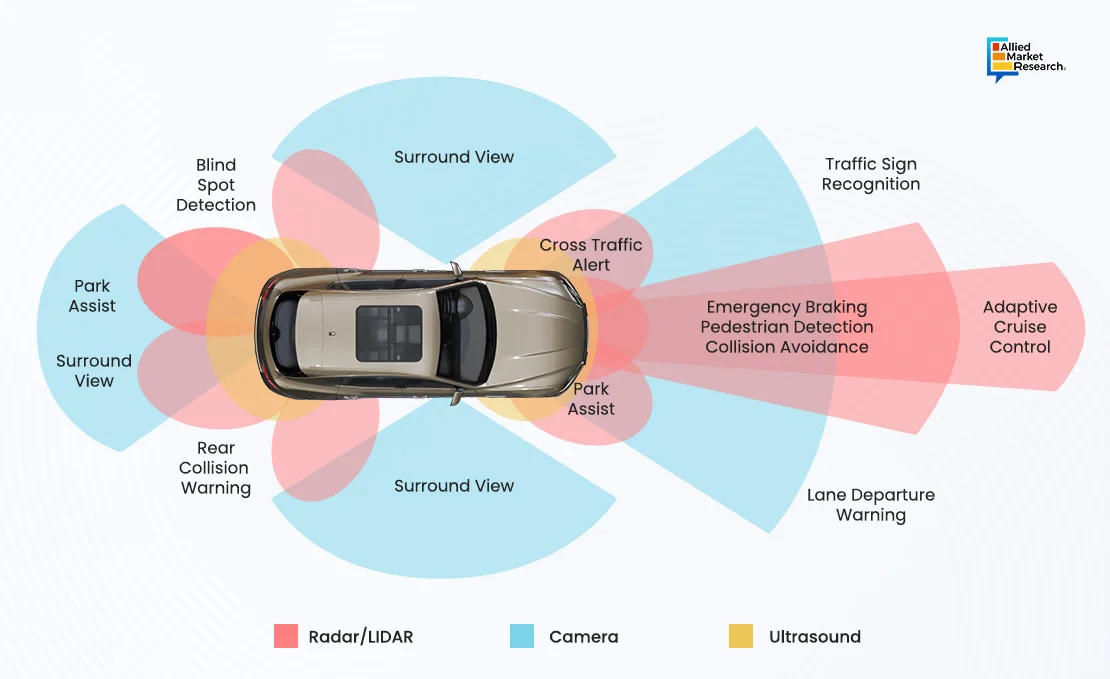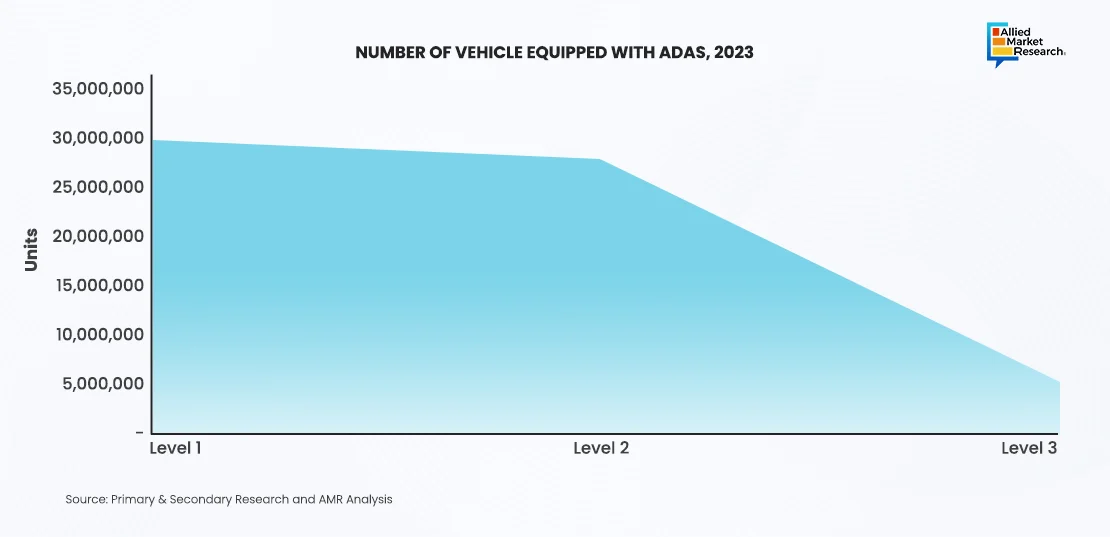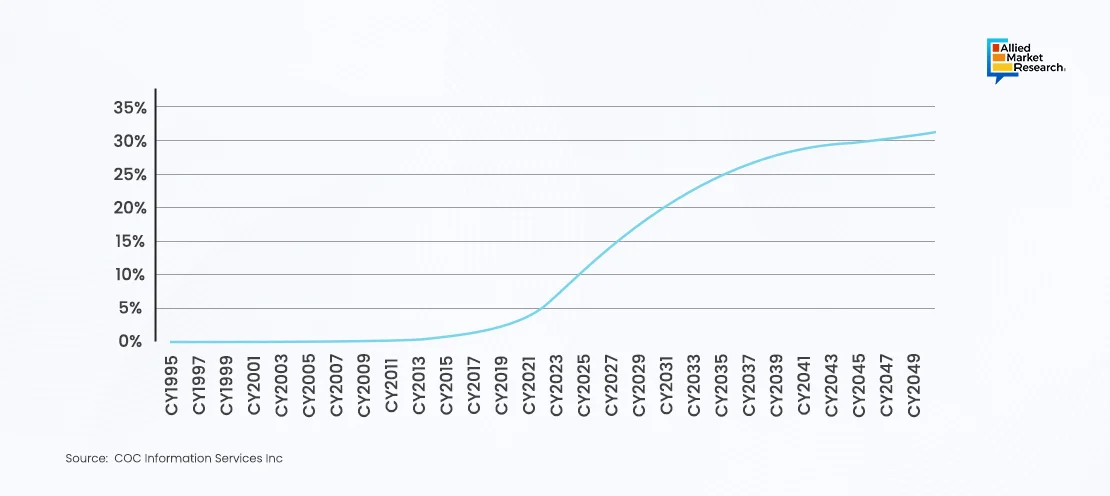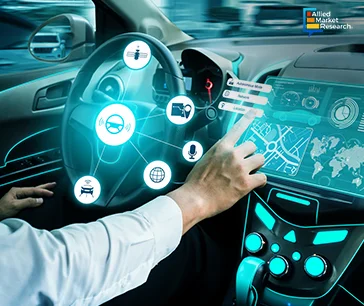Table Of Contents

Lalit Janardhan Katare

Akshata Tiwarkhede
Advanced Driver Assistance Systems (ADAS): Navigating the Path to Enhanced Road Safety

Advanced driver assistance system (ADAS)—one of the prominent applications of artificial intelligence (AI) in cars—represents a groundbreaking advancement in the automotive sector, aimed at revolutionizing road safety and enhancing driving experiences. The risk to reduce car accidents is making ADAS a potential technology as it provides features such as collision warnings and blind-spot monitoring. It utilizes an array of sensors, cameras, and sophisticated algorithms to analyze the vehicle's surroundings, detect potential hazards, and assist the driver in navigating the road safely. Thus, automakers are focusing on leveraging AI to accelerate the development of the automotive industry.
From Cruise Control to Self-driving Mode: The Evolving Landscape of ADAS
Cruise control was the first of the autonomous technologies to emerge in 2002, which has now observed high penetration and is becoming ubiquitous. Furthermore, between 2010 and 2016, cross-traffic alert, automatic emergency braking, and lane keep assistance systems were being increasing installed, thus enhancing safety, efficiency, and the overall driving experience. In addition, the twenty-first century has witnessed the advent of fully autonomous prototypes, which is expected to be followed by the integration of 5G technology to enhance vehicle-to-everything (V2X) communication, facilitating real-time communication among autonomous vehicles and with their surrounding infrastructure.

Unveiling the Potential of Advanced Autonomous Driving
One of the most anticipated future developments in ADAS is the advancement toward fully autonomous vehicleshttps://www.alliedmarketresearch.com/autonomous-vehicle-market. As the technology continues to evolve, it will enable vehicles to operate without human intervention in various driving scenarios, including complex urban environments. For example, these systems may incorporate advanced sensors, such as high-resolution cameras, improved radar, and LiDAR sensors, coupled with powerful computing capabilities and sophisticated algorithms. These systems will enable vehicles to perceive and interpret their surroundings with a high degree of accuracy and reliability, allowing them to navigate through dense traffic, interact with pedestrians & cyclists, and negotiate complex intersections safely and efficiently. The companies such as Waymo, Tesla, and Cruise are already making significant progresses in autonomous driving technology, conducting extensive testing, and refining their systems to achieve higher levels of autonomy. Once fully autonomous vehicles become commercially viable, they hold the potential to revolutionize transportation by reducing traffic congestion, improving mobility for people with disabilities, and enhancing overall road safety.
Enhanced Connectivity Fueling the Future
Integration with emerging technologies such as 5G networks and vehicle-to-everything (V2X) communication is poised to further enhance the capabilities of ADAS. 5G networks offer significantly higher data transmission speed, lower latency, and greater reliability compared to previous generations of wireless technology. This enables ADAS-equipped vehicles to communicate with each other as well as with infrastructure such as traffic lights, road signs, and traffic management systems, in real time. For instance, V2X communication allows vehicles to exchange information about road conditions, traffic congestion, accidents, and other relevant data, enabling proactive decision-making and adaptive driving strategies. This can help improve traffic flow, reduce the likelihood of accidents, and optimize route planning for more efficient travel. Moreover, enhanced connectivity enables cloud-based services and updates, allowing ADAS to access up-to-date maps, traffic information, and software improvements remotely.

The adoption of ADAS is growing steadily, with many new vehicles incorporating this technology as standard or optional equipment. The system is not only used in passenger cars but is also increasingly being adopted in commercial vehicles and public transportation.
These systems operate at varying levels of sophistication; level 1 includes basic features such as adaptive cruise control; level 2 refers to a stage where the vehicle can simultaneously control both steering and acceleration/deceleration, but the driver must remain engaged and vigilant, ready to intervene if necessary; level 3, where the vehicle can manage certain driving tasks autonomously under specific conditions.
Approximately 30 million vehicles were equipped with level 1 systems in 2023. This substantial figure underscores the widespread integration of basic ADAS functionalities across a vast array of vehicles, signifying a shift toward enhanced safety and driver assistance within the automotive sector.
On the other hand, level 2 & level 3 systems have also witnessed growing adoption, wherein level 2 has reached nearly 27 million vehicles which is accompanied by level 3 systems integrated in nearly 12 million vehicles. It is anticipated that the coming years will witness a shifting trend toward the adoption of more advanced ADAS configurations, notably levels 2 and 3, owing to the fact that automotive manufacturers and consumers alike are increasingly recognizing the manifold benefits conferred by these sophisticated safety technologies.
Thus, the proliferation of these cutting-edge systems not only signifies a paradigmatic shift toward safer driving but also highlights the fact that automation and enhanced vehicular safety will redefine the automotive industry in the near future.
Almost all accidents are caused by human error, which can be prevented with ADAS. The pivotal role of the system is to prevent deaths and injuries by reducing the number of car accidents and the serious impact of those that cannot be avoided. With increasing installation of this system in vehicles, the risk of accidents is expected to decline drastically. According to a recent study conducted by the American Automobile Association (AAA) Foundation for Traffic Safety and the University of North Carolina, ADAS is likely to prevent approximately 37 million crashes and 14 million injuries in the coming 30 years, stretching from 2021 to 2050. Dr. David Yang—president and executive director of the AAA Foundation—asserts that ADAS exhibits the potential to completely transform road safety. However, unless the technology is widely adopted and used properly, all its safety benefits will not be realized.

User Needs Addressed by ADAS
Safety Enhancement: ADAS plays a crucial role in enhancing road safety by providing real-time alerts and interventions to help drivers prevent accidents caused by human error. For instance, one common feature is lane departure warning, which alerts the driver when the vehicle unintentionally drifts out of its lane. This can prevent accidents caused by drowsy or distracted driving. Another example is automatic emergency braking (AEB), which uses sensors to detect potential collisions with vehicles or pedestrians and automatically applies the brakes to prevent or mitigate the impact. This feature can be particularly useful in situations where the driver fails to react quickly enough to avoid a collision. Furthermore, blind-spot monitoring systems use sensors to detect vehicles in the driver's blind spots and provide visual or audible alerts to prevent lane-change collisions. By addressing these common causes of accidents, the system significantly contributes to improving overall road safety and reducing the number of accidents and fatalities.
Convenience: In addition to safety enhancement, ADAS offers a range of features that enhance driving convenience, making journeys more comfortable and less stressful for drivers. Adaptive cruise control is one such feature that automatically adjusts the vehicle's speed to maintain a safe following distance from the vehicle ahead. This not only reduces the need for constant speed adjustments but also helps alleviate driver’s fatigue during long journeys. Parking assistance systems such as automatic parallel parking or 360-degree camera views are other convenience features offered by this system. These systems assist drivers in maneuvering into tight parking spaces with ease, reducing the stress and anxiety associated with parking in congested areas. Furthermore, features like traffic sign recognition systems automatically detect and display road signs, speed limits, and other traffic regulations on the vehicle's dashboard, providing drivers with valuable information and enhancing overall driving convenience.
Comfort: Driver comfort is of utmost importance that reduces the physical and mental strain associated with driving, especially in heavy traffic or congested road conditions. Lane-keeping assistance systems use cameras or sensors to detect lane markings and provide gentle steering inputs to help keep the vehicle centered within its lane. This not only reduces the need for constant steering corrections but also helps prevent lane drifting and fatigue. Similarly, traffic jam assist systems utilize adaptive cruise control and lane-keeping assistance to automatically control the vehicle's speed and steering in stop-and-go traffic conditions. By reducing the need for manual control, these systems make driving in traffic more relaxing and less demanding for the driver. Overall, by addressing the primary user needs of safety enhancement, convenience, and comfort, ADAS significantly improves the driving experience and contributes to create safer, more enjoyable journeys for drivers and passengers alike.
The Pace of Progress
Recent technical breakthroughs have focused on improving sensor accuracy, enhancing object detection capabilities, and optimizing decision-making algorithms. In addition, advancements in LiDAR technology have enabled more precise 3D mapping of the vehicle's surroundings, while machine learning algorithms have enhanced the system's ability to interpret complex driving scenarios. For instance, in January 2023, NXP Semiconductors developed 28nm RFCMOS radar one-chip IC family for next-generation ADAS and autonomous driving systems. The new SAF85xx one-chip family combines NXP's high-performance radar sensing and processing technologies into a single device. It offers OEMs new flexibility in addressing short, medium, and long-range radar applications to serve ever more challenging New Car Assessment Program’s safety requirements.

Roadblocks and Turns Ahead
Despite significant progress, ADAS faces several technical limitations and challenges. For instance, it heavily relies on sensors such as cameras, radar, LiDAR, and ultrasonic sensors to perceive the vehicle’s surroundings and detect potential hazards. However, adverse weather conditions such as heavy rain, snow, or fog can significantly impact sensor reliability, leading to reduced visibility and accuracy. To address these challenges, automotive manufacturers and technology companies are investing in the development of advanced sensor technologies capable of operating reliably in diverse weather conditions. For instance, some radar and LiDAR sensors are equipped with heating elements to prevent ice accumulation during cold weather conditions.
Furthermore, lack of standardization leads to compatibility issues in ADAS, limiting their effectiveness and interoperability. Collaborative efforts among industry stakeholders, regulatory bodies, and standardization organizations are essential to address this challenge. These efforts aim to establish common standards and protocols for the development and implementation of the system. For instance, the Society of Automotive Engineers (SAE) has developed standards such as J3016 for defining levels of driving automation and J1939 for vehicle communication protocols, which help promote interoperability and compatibility across different ADAS.
In addition, cybersecurity emerges as a critical concern, as these systems become increasingly connected and reliant on data exchange. For instance, a successful cyber-attack on ADAS could lead to severe consequences, including remote manipulation of vehicle functions, unauthorized access to personal information, or even physical harm to occupants or other road users. Automotive manufacturers and technology companies implement robust cybersecurity measures such as encryption, authentication, intrusion detection systems, and secure communication protocols to mitigate cybersecurity risks.
Thus, overcoming compatibility challenges, ensuring data consistency, and optimizing system performance across diverse technological ecosystems are the key aspects to facilitate seamless integration of ADAS with existing automotive technologies such as GPS navigation and vehicle-to-vehicle communication systems. Collaborative R&D efforts among industry stakeholders are essential to address these integration challenges and unlock the full potential of this technology.
Experts across the industry have anticipated continued development and mainstream adoption of the system, with an emphasis on improving accuracy, reliability, and scalability. However, realizing its full potential requires addressing various concerns pertaining to regulatory framework, supportive infrastructure development, and public acceptance.
- Regulatory Frameworks: Establishing regulations and standards for ADAS deployment and operation is essential to ensure interoperability with different vehicles and enhanced safety.
- Infrastructure Development: Investing in infrastructure upgrades such as road markings, signage, and communication networks facilitates the integration and effectiveness of ADAS.
- Public Acceptance: Building trust and acceptance among consumers is crucial for widespread adoption of ADAS. Educating the public about the benefits and limitations of this technology and addressing concerns related to privacy, cybersecurity, and liability are key steps in this process.
Despite its immense potential, this technology presents certain risks and concerns that need to be addressed.
- System Malfunctions: ADAS is not infallible and may experience malfunctions or errors, leading to unintended consequences or accidents.
- Ethical Dilemmas: Decision-making algorithms used in ADAS may face ethical dilemmas in situations where human life is at stake, raising questions about liability and responsibility.
- Privacy Issues: ADAS relies on collecting and processing massive volume of data, raising concerns about privacy infringement and unauthorized access to personal information.
Driving toward Tomorrow
Autonomous vehicles require careful navigation to unlock their full potential. Bridging the gap between innovation & safety as well as addressing ethical & safety concerns are expected to be crucial in shaping the future of ADAS. Addressing these risks requires robust testing and validation processes, regulatory oversight, and industry collaboration to ensure responsible deployment and use of the technology. By overcoming these challenges and harnessing its full potential, manufacturers can pave the way for safer, smarter, and more sustainable transportation systems in the future.
For further insights, get in touch with AMR analysts.

